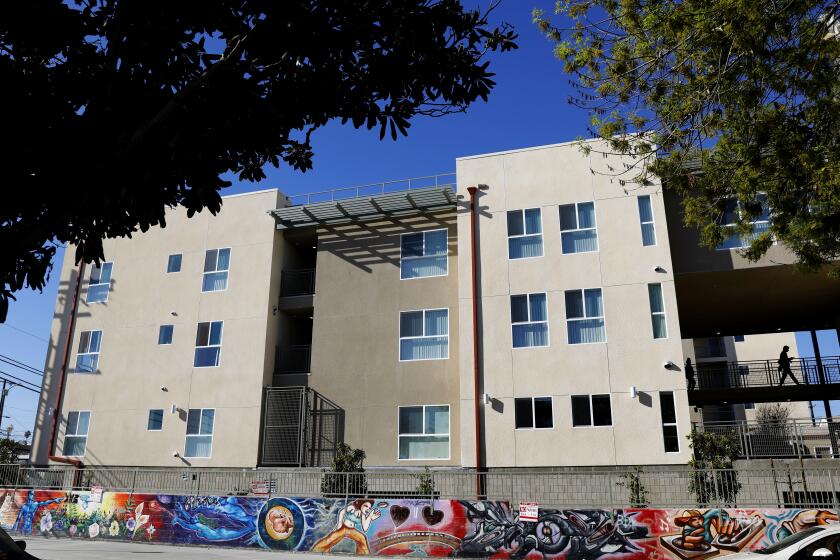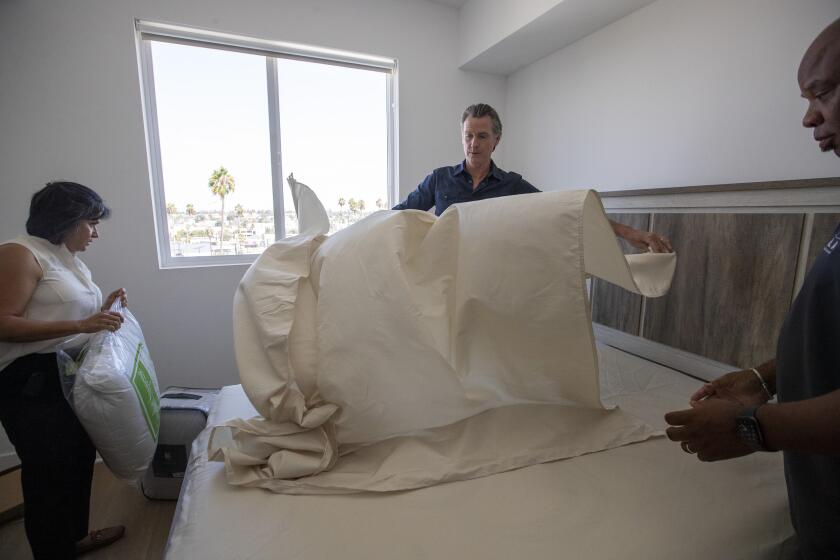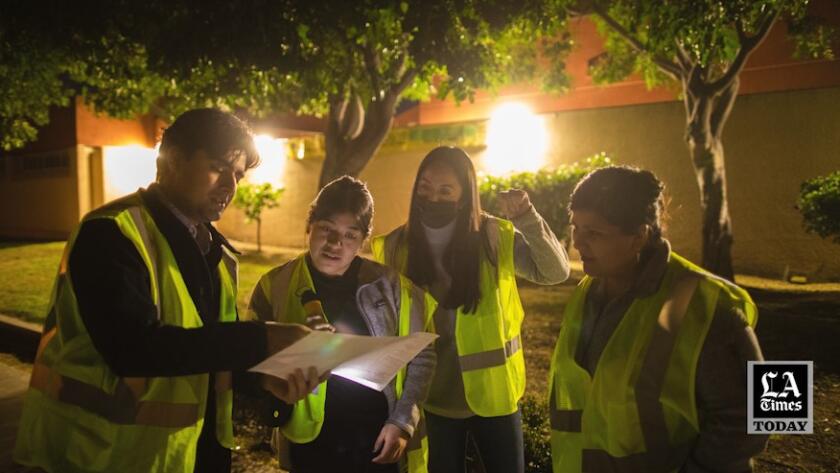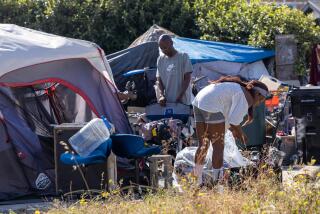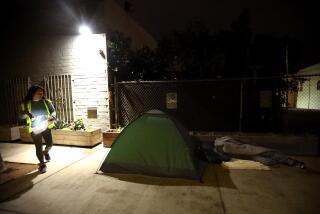Commentary: Is that just a van — or someone’s home? The L.A. County homeless count weighs that and more
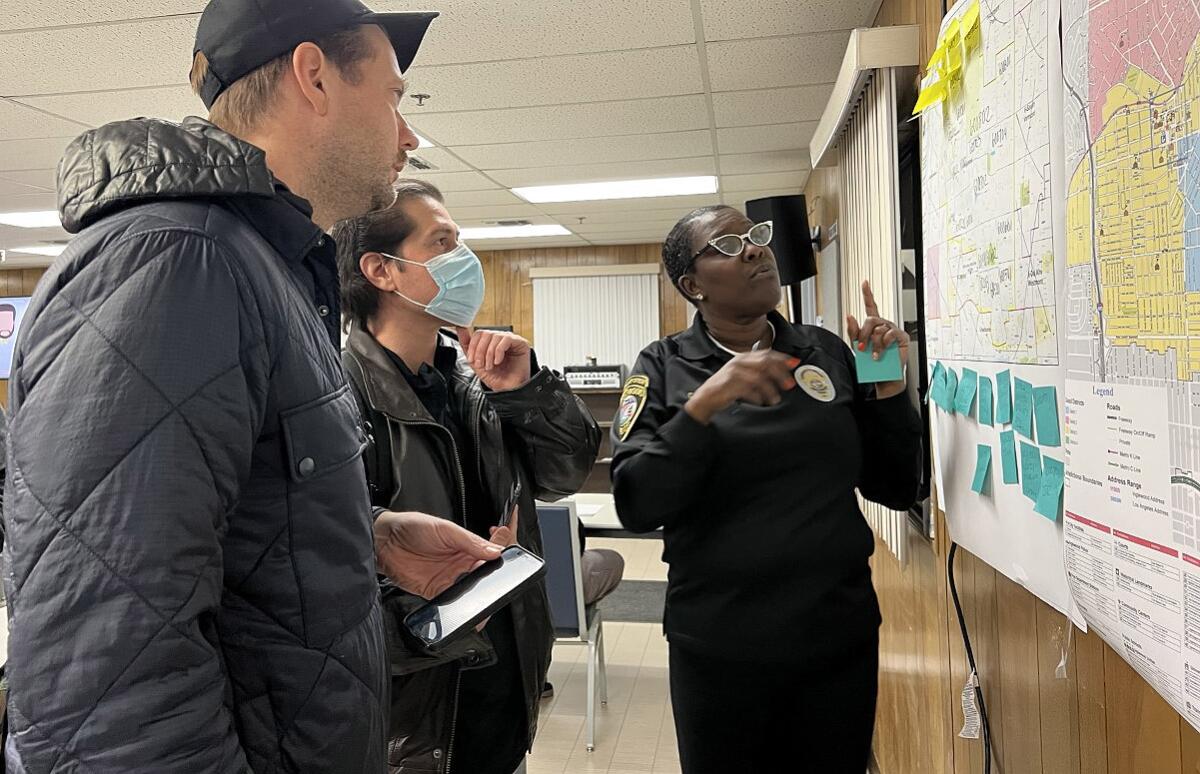
- Share via
The man sits at the bus stop, the glow from his cigarette visible in the dark. It’s 10 p.m. Is he homeless … or waiting for a bus? Or both?
Our three-person team of volunteers on the second night of the 2023 point-in-time count of unhoused people in Los Angeles County will make numerous calls like this for the two-plus hours that we drive the streets of the census tract in Inglewood that we were assigned to count. Rarely do I feel certain it was the right decision.
“Maybe we could ask him if he’s homeless,” I say, only half-joking as we drive past the bus shelter bench a second time. No one in the car thinks that’s a good idea. As volunteers left the deployment center Wednesday evening, the coordinator, Cinder Eller-Kimbell, had instructed us not to shine our flashlights in the eyes of homeless people or talk to them. I had heard the same the previous six times I embarked on this count. And what would he have said anyway? “Why, yes, I am homeless.”
The annual count, which is organized by the Los Angeles Homeless Services Authority, sends out thousands of eager volunteers across the county over three nights to scan the landscape for homeless people as well as tents and vehicles where unhoused people might be living. The Homeless Services Authority also did a tally of the number of people in shelters on Wednesday.
Everyone in my group has done this before. So we have all sat through various training sessions and videos. JC Cangilla, who lives in Ladera Heights and is a father of two young children, is driving. He gets to see a different neighborhood when he does this and he wants to do something to help. “I think it’s a housing problem,” he says.
A new directive by Mayor Karen Bass orders city agencies to work simultaneously to approve plans for homeless housing projects. Will it work to get people housed quicker? It looks promising, but we will be watching.
We head down wide streets with tall palm trees. Overhead in the clear sky, Jupiter perches right above the crescent moon. We see no one except a man walking his dog. On we go to a commercial area.
“There’s a gentleman on a bike,” Cangilla says. The man is rooting through a trash can for recyclables. Plastic bags dangle from the handlebars of his bike. We debate whether we think he is homeless and slowly drive by for a closer look. We try to be low-key but he notices us looking. He wears baggy trousers and a baggy shirt. We record him as homeless via an app on our phones. In the end, he is our only homeless person sighting that night.
Last year the homeless count came under fire when a few census tracts showed seemingly inexplicable decreases or increases in homelessness. The most controversial was an area in Venice where a few hundred homeless people and tents and vehicles had been previously counted but in 2022 tallied as zero. Critics blamed glitches in the app that was being used for the first time by volunteers to record their findings. LAHSA officials stood by the 2022 numbers but this year used a different app from a vendor with experience providing apps for homeless counts.
Although we had no problems using the new app on Wednesday night, LAHSA officials had trouble receiving the information. Our team was asked to email a screenshot of the tabulations. LAHSA spokesperson Ahmad Chapman told me in an email that it was a bandwidth problem that the vendor later corrected. Data from 24 of the 27 census tracts counted in Inglewood on Wednesday had been successfully entered. The unrecorded three would be counted later by LAHSA-coordinated teams, he said.
Gov. Newsom has made record investments to ease homelessness. But ending the humanitarian crisis will require more money over a longer period of time.
The count is neither perfect nor scientific. But it is required by the U.S. Department of Housing and Urban Development and it provides some useful data.
The Rand Corp. just unveiled the results of a yearlong survey of homelessness in L.A.’s skid row, Venice and Hollywood. The report presents a much deeper look at homelessness in those hot spots and how it fluctuated over the course of a year. That’s valuable information to have. But it can’t replace the point-in-time count, which collects a spectacular breadth of information three nights in a row.
Some have suggested that we stop relying on the count and cull more specific information from the database of homeless people filled out by outreach workers and service providers as well as from those who regularly interact with homeless people every day, such as firefighters and librarians.
All these methods could supplement the count. But let’s not forget that unhoused people move around more than most housed people. The populations of encampments ebb and flow. It will always be an approximate census. And even if last year’s number was artificially low, 69,000 homeless people is still way too many. Whether we know the exact number or not, we know for certain there isn’t enough housing for them.
- Share via
Watch L.A. Times Today at 7 p.m. on Spectrum News 1 on Channel 1 or live stream on the Spectrum News App. Palos Verdes Peninsula and Orange County viewers can watch on Cox Systems on channel 99.
More to Read
A cure for the common opinion
Get thought-provoking perspectives with our weekly newsletter.
You may occasionally receive promotional content from the Los Angeles Times.
